Research Topics of Lab Faculty
- Arterial Spin Labeling
- Parallel Excitation
- Reconstruction Methods
- Real-time fMRI
- Functional Connectivity
- Transcranial Magnetic Stimulation
Arterial Spin Labeling
Arterial Spin Labeling (ASL) allows us to acquire quantitative images of brain perfusion without injecting contrast agents. Instead, the blood is magnetically labeled upstream from the tissue of interest before acquiring MR images. At the FMRI laboratory, we are developing new techniques to improve the quality of ASL images. Our aim is to use ASL as a quantitative alternative for functional imaging. We are developing new pulse sequences to improve the ASL signal, and new processing strategies for ASL-based functional MRI data in order to reduce noise, and detect and quantify brain activity.
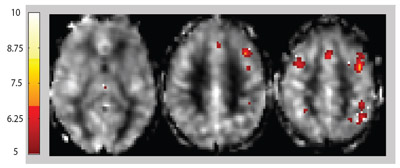
Quantitative images depicting the perfusion changes produced by two weeks of training on the cerebral activation pattern during a working memory task. The changes are overlaid on a map of the resting perfusion. The data are expressed in units of ml/min/100g of tissue.
Researcher: Luis Hernandez-Garcia
Parallel Excitation
Two parts of every MRI acquisition are excitation and reception. One new technology being pursued is parallel excitation, in which multiple independent channels are used to rapidly excite customized patterns (the standard procedure uses a single excitation channel) for:
- Selection of specific regions of the body to allow for a more focused imaging study,
- Correction of intensity variations across the images,
- Correction of magnetic field inhomogeneities by pre-encoding specific compensation patterns to reduce distortions in fMRI.
Our group focuses on excitation pulse design (signal processing), system integration, and applications of parallel excitation.
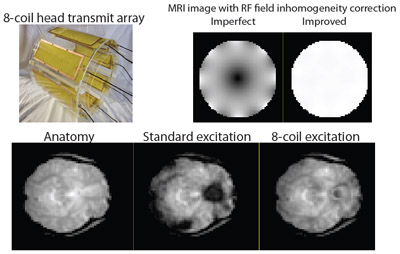
Main field inhomogeneity correction for functional MRI with parallel excitation.
Researchers: Douglas Noll and Jon-Fredrik Nielsen
Reconstruction Methods
In MRI, ideal image reconstruction uses a simple Fourier transform. However, there are a number of cases where this approach does not work well. For example, when magnetic field variations distort the simple Fourier relationship leading to image distortion, and in parallel imaging, where multiple independent channels are acquired using reduced sampling. Our lab, in collaboration with Prof. Fessler (EECS & BME), develops new image reconstruction algorithms that use statistical estimation approaches and models of the MRI physics to produce more stable and artifact-free images as well as estimates of physically and physiologically relevant parameters.

SENSE image and error maps showing reduction of aliasing artifact when using an improved SENSE with a new regularization method.
Researchers: Douglas Noll and Jon-Fredrik Nielsen
Real-time fMRI
Conventional functional MRI collects the BOLD-sensitive MR images of a subject performing a cognitive task, with subsequent image reconstruction and analysis performed offline. Recent advances in fMRI processing allow real-time applications (within same scan, with minimal lag): online data quality control, real-time functional activation monitoring, and interactive paradigms based on the subjects dynamic functional activity. At the FMRI laboratory, we are developing pattern classification techniques to investigate their use in real-time fMRI neurofeedback to modulate craving.
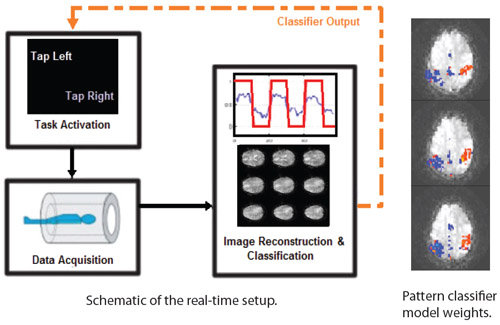
Researchers: Scott Peltier and Luis Hernandez-Garcia
Functional Connectivity
Recent fMRI have shown slowly varying timecourse fluctuations that are temporally correlated between functionally related areas (e.g. motor, visual, attentional networks), even at rest. Further studies have demonstrated altered connectivity for various neurological states. Thus, functional connectivity is potentially important as an indicator of regular neuronal activity. Our current work involves investigating and characterizing these functional connectivity patterns in control and patient groups, including detection using model-free analysis methods.
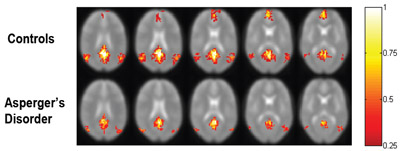
Figure showing reduced functional connectivity within the default mode network in subjects with Asperger's disorder as compared to healthy controls.
Researcher: Scott Peltier
Transcranial Magnetic Stimulation
Transcranial Magnetic Stimulation (TMS) is a technique to produce neuronal excitations in the brain non-invasively. A strong electric field is produced by a coil that is held next to the subject's head, and this field causes the neurons to fire. This is a useful research and therapy tool. At the FMRI laboratory, we are conducting several studies of cognitive function using TMS. We are also developing techniques to improve the targetting capabilities of the TMS technique, which is not very accurate in its current state.
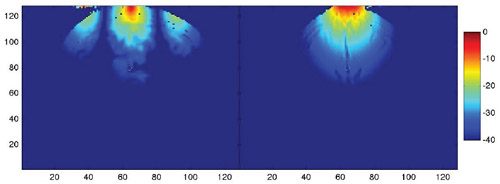
Calculated Electric Field Pattern produced on a human brain by a new TMS coil design.
Researchers: Luis Hernandez-Garcia